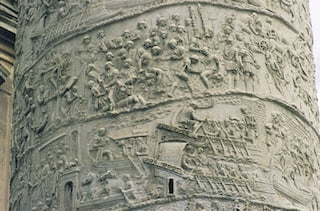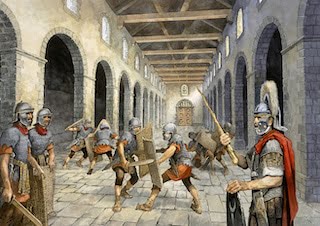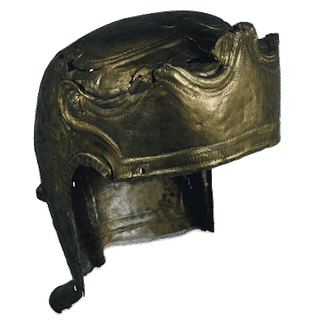

Remember the proverb “All work and no play makes Jack a dull boy” (appeared first in James Howell’s Proverbs in English, Italian, French and Spanish -1659).
We can’t say the Romans were dull, so tomorrow we’ll look at…
Romans 4
Abraham Saved by Faith
1 What shall we say then that Abraham our father, as pertaining to the flesh, hath found?
“Abraham our father” – the Jews of Jesus’ time sued Abraham as an example of justification by works, but Paul holds him up as a shining example of righteousness by faith (see Gal 3:6-9; Heb 11:8-19).
2 For if Abraham were justified by works, he hath whereof to glory; but not before God.
3 For what saith the scripture? Abraham believed God, and it was counted unto him for righteousness.
The reference is to Gen 15:6, where nothing is mentioned about works.

The diploma was a notarized copy of an original constitutio (decree) issued by the emperor in Rome, listing by regiment (or unit) the eligible veterans.
The constitutio, recorded on a large bronze plate, was lodged in the military archive at Rome (none such has been found; presumably they were melted down in later times).
We are not saved through works, but by faith alone – Eph 2:8-9.
“Counted unto him” – Abraham had kept no law, rendered no service and performed no ritual that earned credit to his account before God. His belief in God, who had made promises to him, was credited to him as righteousness.
Realize Moses has not been born yet. Therefore, there is no Bible or laws written. Abraham was righteous to God through the faith he had in Him.
4 Now to him that worketh is the reward not reckoned of grace, but of debt.
5 But to him that worketh not, but believeth on him that justifieth the ungodly, his faith is counted for righteousness.
6 Even as David also describeth the blessedness of the man, unto whom God imputeth righteousness without works,
4:6-8 – God doesn’t not continue to impute unrighteousness to the sinner who repents, but forgives him when he confesses (see Ps 32:3-5; Eze 18:23, 27-28, 32, 33:14-16).
7 Saying, Blessed are they whose iniquities are forgiven, and whose sins are covered.
8 Blessed is the man to whom the Lord will not impute sin.
9 Cometh this blessedness then upon the circumcision only, or upon the uncircumcision also? for we say that faith was reckoned to Abraham for righteousness.

The Roman Soldiers were if nothing else effective and they approached battle in a calculated way.
When an enemy employed a weapon successfully against the legions the Romans would often adopt that weapon into their own military.
Regardless of which weapons the Romans marched with the end result was ten centuries of military domination, and the Romans depended upon military might to create and sustain their empire.
So with no further ado, here are the weapons that created, defended and eventually lost the greatest empire the Western world has ever known.
10 How was it then reckoned? when he was in circumcision, or in uncircumcision? Not in circumcision, but in uncircumcision.
11 And he received the sign of circumcision, a seal of the righteousness of the faith which he had yet being uncircumcised: that he might be the father of all them that believe, though they be not circumcised; that righteousness might be imputed unto them also:
12 And the father of circumcision to them who are not of the circumcision only, but who also walk in the steps of that faith of our father Abraham, which he had being yet uncircumcised.
“Father of circumcision” – Abraham is also the father of believing Jews. Thus his story shows that for Jews and Gentile alike there is only one way of justification – the way of faith in Jesus Christ.
13 For the promise, that he should be the heir of the world, was not to Abraham, or to his seed, through the law, but through the righteousness of faith.
14 For if they which are of the law be heirs, faith is made void, and the promise made of none effect:
“They which are of the law” – those whose claim to the inheritance is based on the fulfillment of the law.
15 Because the law worketh wrath: for where no law is, there is no transgression.
“Law worketh wrath” – the law, because it reveals sin and even stimulates it, produces wrath, not promise.

It was probably constructed under the supervision of the architect Apollodorus of Damascus at the order of the Roman Senate. It is located in Trajan’s Forum, built near the Quirinal Hill, north of the Roman Forum.
Completed in 113 A.D., the freestanding column is most famous for its spiral bas relief, which artistically describes the epic wars between the Romans and Dacians (101–102 and 105–106).
Its design has inspired numerous victory columns, both ancient and modern.
“Transgression” – overstepping a clearly defined line. Where there is no law there is still sin, but it does not have the character of transgression or violation.
16 Therefore it is of faith, that it might be by grace; to the end the promise might be sure to all the seed; not to that only which is of the law, but to that also which is of the faith of Abraham; who is the father of us all,
“Which is of the law” – Jewish Christians that cling to the law and not of faith in Jesus Christ.
“Which is of the faith of Abraham” – Gentile Christians who share Abraham’s faith but who, like Abraham, do not possess the law.
17 (As it is written, I have made thee a father of many nations,) before him whom he believed, even God, who quickeneth the dead, and calleth those things which be not as though they were.
“Before him” – God considers Abraham the father of Jews and believing Gentiles alike, no matter how others (especially Jews) may see him.
“God, who quickeneth the dead” – the main reference is to the birth of Isaac through Abraham and Sarah, both of whom were far past the age of childbearing. Secondarily Paul alludes also to the resurrection of Christ.
“Calleth…as though they were” – God has the ability to create out of nothing, as He demonstrated in the birth of Isaac.
18 Who against hope believed in hope, that he might become the father of many nations, according to that which was spoken, So shall thy seed be.
“Against hope believed in hope” – when all hope, as a human possibility, failed, Abraham placed his hope in God.
19 And being not weak in faith, he considered not his own body now dead, when he was about an hundred years old, neither yet the deadness of Sara’s womb:
“Being not weak in faith” – Abraham had some anxious moments (see Gen 17:17-18), but God didn’t count these against him because God knew where his heart was.
“Considered not” – faith doesn’t refuse to face reality but looks beyond all difficulties to God and His promises.
20 He staggered not at the promise of God through unbelief; but was strong in faith, giving glory to God;
21 And being fully persuaded that, what he had promised, he was able also to perform.
22 And therefore it was imputed to him for righteousness.

23 Now it was not written for his sake alone, that it was imputed to him;
24 But for us also, to whom it shall be imputed, if we believe on him that raised up Jesus our Lord from the dead;
“But for us also” – as Abraham was justified because he believed in God who brought life from the dead, so we will be justified by believing “on him that raised up Jesus our Lord from the dead.”
25 Who was delivered for our offences, and was raised again for our justification.
The Roman Army

Who was in the Roman army?
Only men could be in the Roman Army. No women. Every Roman soldier was a Roman citizen. He had to be at least 20 years old.
He was not supposed to get married while he was a soldier. Most soldiers in the Roman Empire came from countries outside Italy.
There were Roman soldiers from Africa, France, Germany, the Balkans, Spain and the Middle East.
Soldiers had to stay in the army for at least 25 years! Then they could retire, with a pension or a gift of land to farm.
Old soldiers often settled down to old age together, in a military town or colonia.
What was a legion?

There is also a Neolithic burial on the site, and the remains of an Anglo-Saxon hall can be seen.
Birdoswald has also been traditionally associated with Camlan, the legendary site of King Arthur’s last battle.
The fort is remarkably complete, and offers an enjoyable glimpse of life on the Roman frontier long ago.
The site covers about five acres on high ground above the river gorge, and remains of the early turf wall which preceded Hadrian’s Wall are clearly visible.
There were about 30 legions in the Roman army. Each legion had between 4,000 and 6,000 soldiers, called legionaries. Each legion had ten cohorts.
Each cohort was made up of six troops of about 80 legionaries, called centuries. Each century was led by a centurion.
A centurion carried a short rod, to show his importance. He could also use his stick to beat any soldier who disobeyed an order. The officer commanding the whole legion was called a legate.
What other soldiers did the Romans have?
Legionaries were the best Roman soldiers, and the best paid. There were other soldiers though. An auxiliary was a soldier who was not a Roman citizen.
He was paid a third as much as a legionary. Auxiliaries guarded forts and frontiers, but also fought in battles, often in the front lines, where it was the most dangerous.
Some soldiers had special skills. They shot bows and arrows, flung stones from slingshots, or could swim rivers to surprise an enemy – like modern commandos.
Artillery soldiers fired giant catapults, called onagers in Latin, machines that fired rocks or balls of burning tar. The Romans used big wind-up crossbows, called ballistas in Latin, too.
Usually, Romans liked to fight on foot. They used cavalry (soldiers riding horses) to chase a fleeing enemy. In a battle, the cavalry often lined up either side of the infantry (foot-soldiers).
What armour and weapons did the Romans have?
We know about Roman armour and weapons from Roman pictures and statues, and from finds by modern archaeologists.

A Roman soldier wore armour made from strips of iron and leather (lorica segmentata in Latin). On his head was a metal helmet (galea).
He carried a rectangular shield (scutum), curved so it protected his body. The shield was made of wood and leather.
The soldier’s main weapons were a short sword for stabbing (gladius) and a long spear, or javelin (pilum) for throwing.
The javelin had a sharp iron point, and a thin, bendy shaft. When it hit an enemy’s shield, the point stuck in, but the shaft bent.
This made it difficult to pull out. The long spear shaft got in the way, so the enemy soldier had to throw away his shield.
How well-trained were Roman soldiers?
Roman soldiers kept fit by running, marching and practice-fighting. They could march 20 miles (30 km) a day wearing armour.

A 2,000-year-old Roman cavalry helmet has shed new light on the conquest of Britain after experts pieced it back together 10 years since its discovery in an Iron Age shrine.
The ‘Hallaton Helmet’ a 2,000-year-old Roman helmet found at an old Iron Age site at Hallaton in Leciestershire in 2002 is to go on display at the Harborough
Constructed of sheet iron, the helmet, once decorated with gold leaf, is the only one to have been found in Britain with its silver gilt plating intact.
The helmet features scenes of Roman military victory, including the bust of a woman flanked by lions, and a Roman Emperor on horseback with the goddess Victory flying behind and a cowering figure, possibly a native Briton, being trampled under his horse’s hooves.
The object is believed to have been buried in the years around Roman Emperor Claudius’s invasion of Britain in 43 A.D.
The ”distinct possibility” that it belonged to a Briton serving in the Roman cavalry before the conquest of Britain raises questions about the relationship between Romans and Britons.
It is thought that the helmet may have been buried at what was a local shrine on the Briton’s return to the East Midlands, as a gift to the gods.
They could swim or cross rivers in boats, build bridges, and smash their way into forts.
Each man carried his weapons and shield, some food and camping equipment (such as spare clothes, cooking pot and an axe or spade).
Roman soldiers almost always obeyed orders. They usually fought in lines, marching forward with their shields facing the enemy.
If they were being fired at from above (with arrows or rocks), the men would lift their shields over their heads for protection.
They looked like a tortoise, so they called this formation the testudo (Latin for tortoise).
Fun Facts:
Roman soldiers wore sandals, with iron studs on the leather soles. Hard-wearing, but easy to slip when running on wet stones!
Soldiers far from home got lonely. Roman mothers sent letters and parcels from home to cheer them up.
Roman soldiers wore their swords on the right at first. By the AD 300s most Romans wore their swords on the left – as centurions always had.
Roman cavalrymen rode without stirrups. Stirrups hadn’t been invented.
The dragon on the Welsh flag is said to be a link to dragons on standards carried by Roman soldiers.
…Leisure.
Visits: 0
